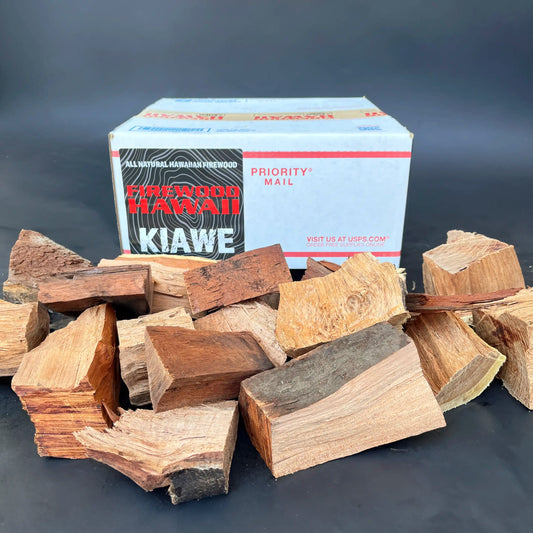
Everything You Need to Know About Kiawe Wood
Share

Kiawe Tree Digital Artwork
We're proud to share our love for this remarkable wood and help you understand more about it.
Kiawe wood is cherished all over the world, especially in Hawaii, for its unique qualities that make it not only a great firewood but a valuable resource in many aspects of Hawaiian life.

Kiawe wood pieces. Sustainably sourced.
Let’s dive into some common questions about Kiawe wood. Click on the question to have the answer drop down.
What is the English name for Kiawe Wood?
Kiawe wood is actually already the English name. The tree from which Kiawe wood is sourced is called Prosopis pallida. It is a species of mesquite tree native to South America, specifically Colombia, Ecuador, and Peru.
Is Mesquite and Kiawe the Same Thing?
Kiawe and mesquite are not exactly the same thing, although they are closely related. They are both species of the Prosopis genus, known for their hardiness and resilience in arid climates. Kiawe, or Prosopis pallida, is a specific type of mesquite, often distinguished by its slightly sweeter smoke flavor compared to other mesquite varieties. This makes Kiawe particularly prized in Hawaii for smoking and grilling.
What is the Best Wood to Smoke in Hawaii?
Among the various types of wood available in Hawaii for smoking, Kiawe is undoubtedly one of the best and most popular. Its unique, slightly sweet and robust smoke flavor is a favorite for enhancing the taste of meats, fish, and other dishes. In fact, it's a significant element of Hawaiian barbecue and cuisine, known for lending a unique, mouth-watering flavor that's hard to replicate with any other wood.
What is the Kiawe Tree Used For?
The Kiawe tree is highly versatile and serves many uses in Hawaii. Its wood, as we've discussed, is ideal for smoking and grilling food. Beyond that, the Kiawe tree's beans are often ground into flour, providing a gluten-free alternative for baking. The tree also offers environmental benefits, as it helps prevent soil erosion and provides shade. In many regions, it is also a source of honey, as bees love its flowers.
How did Kiawe Tree Get to Hawaii?
The Kiawe tree was brought to Hawaii from South America in the early 19th century, around 1828. It was initially introduced as a shade tree for cattle and quickly adapted to the arid, volcanic soil of the islands. Over time, it has become a defining part of the Hawaiian landscape.
What Does Kiawe Mean in Hawaiian?
The word "Kiawe" in Hawaiian refers directly to the Kiawe tree (Prosopis pallida). However, it doesn't have a specific meaning or translation in the Hawaiian language. It's simply the name the locals have given to this iconic and crucial tree species.
Is it spelled Keawe Wood or Kiawe Wood?
The correct spelling is Kiawe wood, not Keawe. The name might be confused or misspelled due to the phonetic similarities, but when referring to the Prosopis pallida, the name Kiawe is used in Hawaii.
How Do You Pronounce Kiawe?
Kiawe is pronounced "kee-AH-vey." The stress is on the second syllable, and all three vowels are distinctly pronounced. It rolls off the tongue smoothly, just like the smoke it produces for that perfect Hawaiian barbecue!
Is Kiawe an Acacia Tree?
No, Kiawe is not an acacia tree. Kiawe is a type of mesquite tree from the genus Prosopis. While it shares some similarities with acacia trees, such as its thorny branches and adaptation to arid climates, it belongs to a different family of plants. The wood of Kiawe and acacia have different characteristics, which can affect their respective uses, particularly in cooking and smoking.
What is the Kiawe Wood Used For?
Kiawe wood is highly prized in Hawaii for its diverse applications. One of its most popular uses is in cooking, particularly for smoking and grilling, where it imparts a distinct, slightly sweet, and robust smoke flavor to the food. This flavor profile is especially valued in traditional Hawaiian barbecue. But the uses of Kiawe wood don't stop there. It's a dense and hard wood, making it excellent for construction and creating charcoal. Its durability also makes it suitable for making furniture and other wooden crafts. Additionally, in some places, the wood is used as fuel for heating homes.
What Does a Kiawe Tree Look Like?
The Kiawe tree, or Prosopis pallida, is a medium-sized tree that typically grows to heights between 20 to 30 feet, although some can reach up to 50 feet. It's a thorny tree with a rugged and irregular shape, bearing a dense canopy of compound leaves that are bright green and somewhat feathery in appearance. One of the distinguishing features of the Kiawe tree is its long, slender seed pods, which hang from its branches and can be up to 8 inches long. These seed pods are yellowish to red.
We hope that this blog has helped answer some of your questions about Kiawe wood. If you're interested in experiencing the remarkable qualities of this wood, check out our premium Hawaiian Kiawe firewood offerings.
We're here to provide the finest Kiawe wood Hawaii has to offer.








